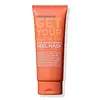What's inside
What's inside
 Key Ingredients
Key Ingredients

 Benefits
Benefits

 Concerns
Concerns

 Ingredients Side-by-side
Ingredients Side-by-side

Water
Skin ConditioningPolyvinyl Alcohol
Alcohol Denat.
AntimicrobialPolysorbate 80
EmulsifyingButylene Glycol
HumectantGlycerin
HumectantBetaine
HumectantPhenoxyethanol
PreservativeSodium Polyacrylate
AbsorbentC13-14 Isoparaffin
EmollientParfum
MaskingLaureth-7
EmulsifyingCetyl Ethylhexanoate
EmollientCitrus Grandis Seed Extract
AstringentCarica Papaya Fruit Extract
Skin ConditioningAscorbyl Palmitate
AntioxidantCI 17200
Cosmetic ColorantCI 19140
Cosmetic ColorantWater
Skin ConditioningGlycolic Acid
BufferingGlycerin
HumectantCetyl Alcohol
EmollientGlyceryl Stearate Se
EmulsifyingCocos Nucifera Oil
MaskingPapain
Skin ConditioningButyrospermum Parkii Butter
Skin ConditioningCeteareth-20
CleansingPropylene Glycol
HumectantIsopropyl Myristate
EmollientArginine
MaskingArgania Spinosa Kernel Oil
EmollientSalicylic Acid
MaskingUrea
BufferingTocopheryl Acetate
AntioxidantPanthenol
Skin ConditioningBacillus Ferment
Skin ConditioningMauritia Flexuosa Fruit Oil
Skin ConditioningAloe Barbadensis Leaf Juice
Skin ConditioningCitrus Paradisi Fruit Extract
Skin ConditioningXanthan Gum
EmulsifyingPhenoxyethanol
PreservativeSodium Hydroxide
BufferingPolyacrylamide
Carbomer
Emulsion StabilisingC13-14 Isoparaffin
EmollientEthylhexylglycerin
Skin ConditioningLaureth-7
EmulsifyingSodium Phytate
Citric Acid
BufferingPotassium Sorbate
PreservativeAlcohol
AntimicrobialSodium Benzoate
MaskingWater, Glycolic Acid, Glycerin, Cetyl Alcohol, Glyceryl Stearate Se, Cocos Nucifera Oil, Papain, Butyrospermum Parkii Butter, Ceteareth-20, Propylene Glycol, Isopropyl Myristate, Arginine, Argania Spinosa Kernel Oil, Salicylic Acid, Urea, Tocopheryl Acetate, Panthenol, Bacillus Ferment, Mauritia Flexuosa Fruit Oil, Aloe Barbadensis Leaf Juice, Citrus Paradisi Fruit Extract, Xanthan Gum, Phenoxyethanol, Sodium Hydroxide, Polyacrylamide, Carbomer, C13-14 Isoparaffin, Ethylhexylglycerin, Laureth-7, Sodium Phytate, Citric Acid, Potassium Sorbate, Alcohol, Sodium Benzoate
Ingredients Explained
These ingredients are found in both products.
Ingredients higher up in an ingredient list are typically present in a larger amount.
This ingredient is also known as "C13-14 Isoalkane".
C13-14 Isoparaffin is created from petroleum-based mineral oils. It is an emollient and helps thicken a product.
As an emollient, it helps keep the skin soft and smooth by creating a barrier on top. This barrier traps moisture in, keeping the skin hydrated.
C13-14 Isoparaffin may not be fungal-acne safe.
Learn more about C13-14 IsoparaffinGlycerin is already naturally found in your skin. It helps moisturize and protect your skin.
A study from 2016 found glycerin to be more effective as a humectant than AHAs and hyaluronic acid.
As a humectant, it helps the skin stay hydrated by pulling moisture to your skin. The low molecular weight of glycerin allows it to pull moisture into the deeper layers of your skin.
Hydrated skin improves your skin barrier; Your skin barrier helps protect against irritants and bacteria.
Glycerin has also been found to have antimicrobial and antiviral properties. Due to these properties, glycerin is often used in wound and burn treatments.
In cosmetics, glycerin is usually derived from plants such as soybean or palm. However, it can also be sourced from animals, such as tallow or animal fat.
This ingredient is organic, colorless, odorless, and non-toxic.
Glycerin is the name for this ingredient in American English. British English uses Glycerol/Glycerine.
Learn more about GlycerinLaureth-7 is created by the ethoxylation of lauryl alcohol using ethylene oxide. Lauryl alcohol is a fatty alcohol with hydrating properties.
This ingredient is an emulsifier and cleansing ingredient. As an emulsifier, it is used to prevent ingredients from separating. It also helps cleanse the skin by gathering dirt, oil, and pollutants to be rinsed away.
Phenoxyethanol is a preservative that has germicide, antimicrobial, and aromatic properties. Studies show that phenoxyethanol can prevent microbial growth. By itself, it has a scent that is similar to that of a rose.
It's often used in formulations along with Caprylyl Glycol to preserve the shelf life of products.
Water. It's the most common cosmetic ingredient of all. You'll usually see it at the top of ingredient lists, meaning that it makes up the largest part of the product.
So why is it so popular? Water most often acts as a solvent - this means that it helps dissolve other ingredients into the formulation.
You'll also recognize water as that liquid we all need to stay alive. If you see this, drink a glass of water. Stay hydrated!
Learn more about Water